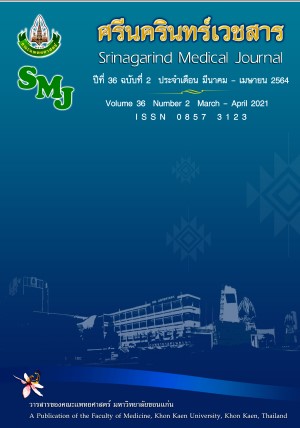ความสัมพันธ์ระหว่างข้อมูลทางอุตุนิยมวิทยากับอุบัติการณ์การเกิดโรคหลอดเลือดหัวใจ
Abstract
หลักการและวัตถุประสงค์: โรคหัวใจและหลอดเลือดเป็นสาเหตุของการเสียชีวิตทั่วโลก ความเสี่ยงของการเกิดโรคเรื้อรังนั้นมีสาเหตุมาจากปัจจัยทางพันธุกรรมและสิ่งแวดล้อม การวิจัยครั้งนี้มีวัตถุประสงค์เพื่อประเมินและรายงานความสัมพันธ์ระหว่างโรคหลอดเลือดหัวใจและสิ่งแวดล้อม
วิธีการศึกษา: เป็นการศึกษาย้อนหลังจากข้อมูลอุตุนิยมวิทยาจาก the Modern-Era Retrospective Analysis for Research and Applications, version 2 (MERRA-2) และจำนวนผู้ป่วยนอกรายใหม่ในประเทศไทยจากศูนย์ข้อมูลสนับสนุนการจัดบริการสุขภาพที่ได้รับอนุมัติจากกระทรวงสาธารณสุขระหว่างวันที่ 1 มกราคม 2556 ถึงวันที่ 31 ธันวาคม 2560
ผลการศึกษา: จำนวนผู้ป่วยโรคหัวใจและหลอดเลือดรายใหม่ในประเทศไทยตั้งแต่วันที่ 1 มกราคม 2556 ถึงวันที่ 31 ธันวาคม 2560 แสดงแนวโน้มที่เพิ่มสูงขึ้นอย่างต่อเนื่อง โดยมีค่าเฉลี่ย 1,990 รายต่อเดือน จากโมเดลอนุกรมเวลามีเพียง 3 ปัจจัยที่เกี่ยวข้องกับการมีผู้ป่วยโรคหัวใจและหลอดเลือดรายใหม่อย่างมีนัยสำคัญ คือ อุณหภูมิ ความดันพื้นผิว และความชื้น
สรุป: ข้อมูลอุตุนิยมวิทยาได้แก่ อุณหภูมิ ความดันบรรยากาศ และความชื้นที่มีผลกับการมีผู้ป่วยโรคหัวใจและหลอดเลือดรายใหม่
คำสำคัญ: โรคหัวใจและหลอดเลือด; ข้อมูลอุตุนิยมวิทยา; อุณหภูมิ; ความดันบรรยากาศ; ความชื้น
Background and Objectives: Cardiovascular disease (CVDs) is the leading cause of death worldwide. The risks of developing chronic diseases are attributed to both genetic and environmental factors. The aim of this research was to assess and report on correlation between cardiovascular disease and environment.
Methods: This retrospective study evaluated meteorological data from the Modern-Era Retrospective Analysis for Research and Applications, version 2 (MERRA-2) along with monthly new CVDs cases in Thailand from Health Data Center (HDC) v 4.0 approved by the Ministry of Public Health (MOPH) during January 1, 2013 to December 31,2017.
Results: Monthly mean values of new CVDs cases in Thailand from January 1, 2013 through December 31, 2017 display increasing trends over time with mean 1990 cases/month. By the time series model, only 3 factors related with new CVDs cases significantly including temperature, surface pressure, and humidity.
Conclusion: Meteorological data like temperature, atmosphere pressure and humidity has effect to CVDs event.
Keywords: Cardiovascular disease; Meteorological data; Temperature; Atmosphere pressure; Humidity


